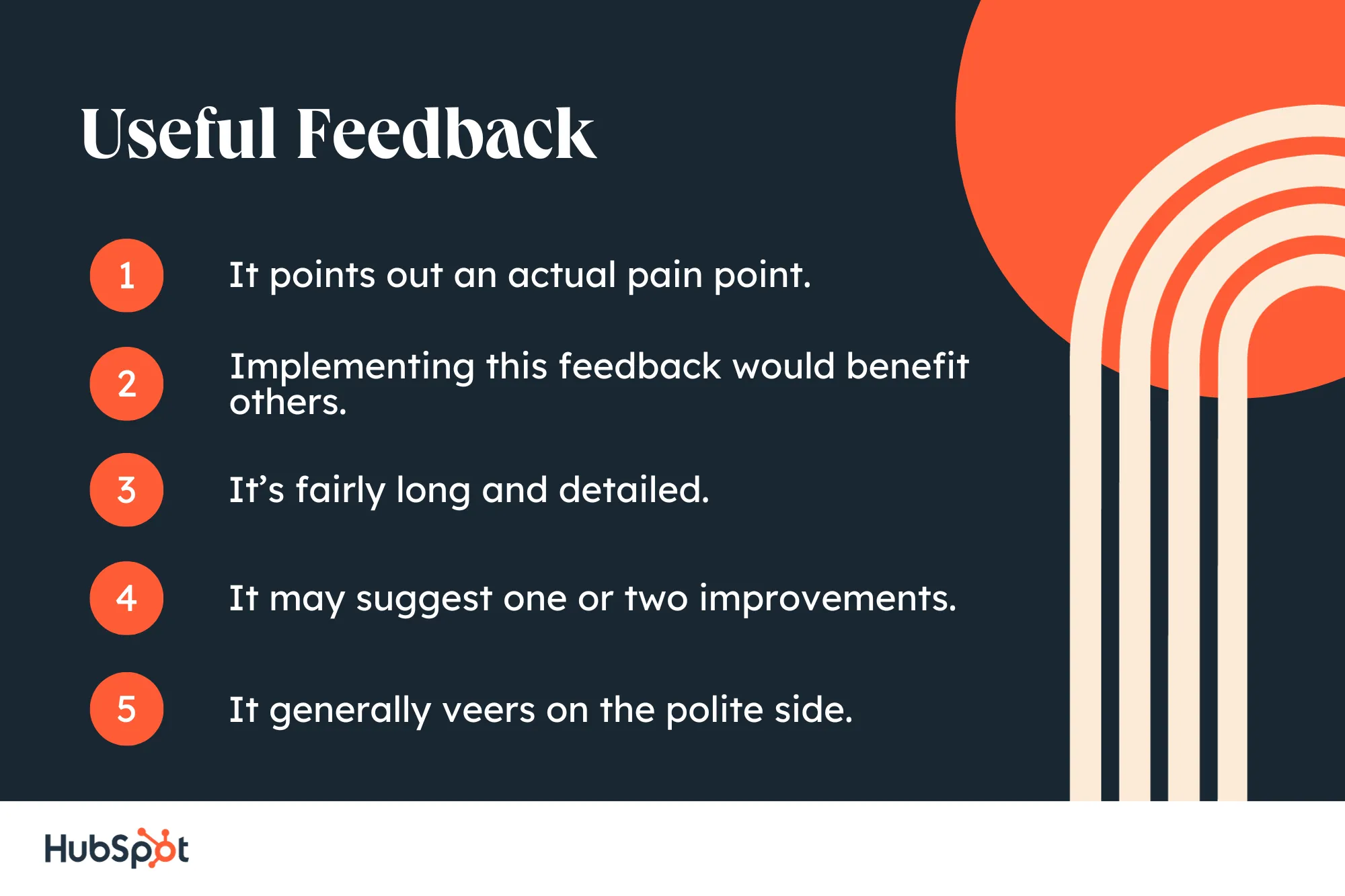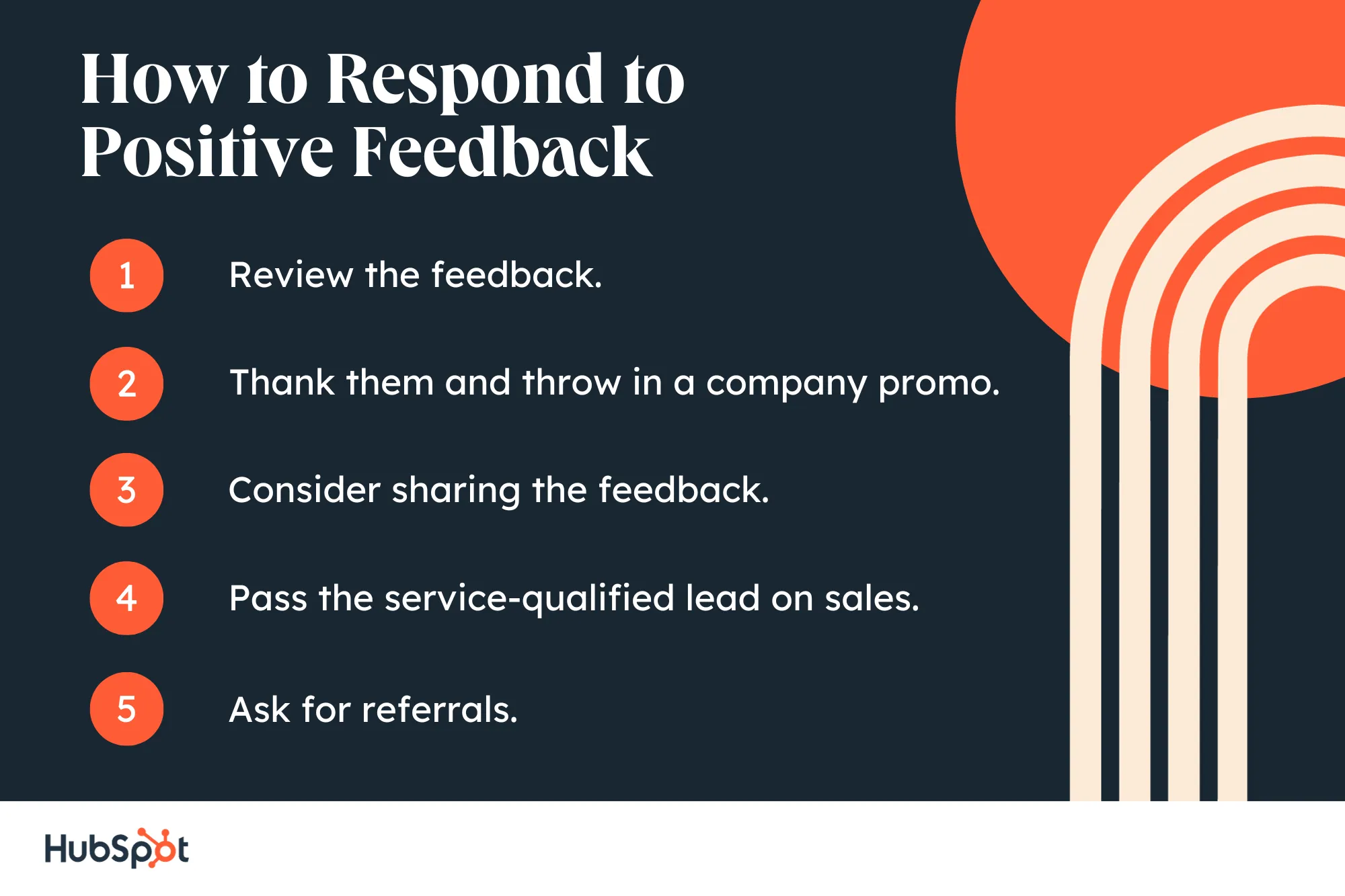I’m here to walk you through what to do with customer feedback once you’ve gathered it. I’ll share how to determine what’s useful feedback, how to respond to negative (and positive comments), and where social media factors into this.
Why does customer feedback matter?
Your company depends on your customer base. So, you must cultivate a positive relationship with your customers and stay informed about what they enjoy and dislike about your products/services. The stronger your connection is with your customers, the better your understanding of how the rest of the world perceives your company.
Without feedback, you won’t know if you’re meeting the needs of your customers. You also won’t know if they use your products as intended or wish to do business with you again.
Feedback fuels satisfaction, which is one of the main benefits of garnering customer feedback. With customer feedback, you learn your customers’ unfiltered thoughts about your company and its offerings. Since feedback is directly connected to customer satisfaction, you get a window into your customers’ desires and experiences.
Again, investing time in gathering and listening to customer feedback is necessary for businesses to understand, appreciate, and honor their customers genuinely. Helpscout reports, “Customer feedback is important because it serves as a guiding resource for the growth of your company.”
Simply put, harnessing the power of customer feedback helps you make strategic choices and maximize ROI.
Determining Useful vs. Useless Feedback
Let’s be honest: Not all customer feedback will be positive. When learning what to do with customer feedback, you’ll have to determine if it’s useful or not.
While positive and negative feedback are equally important, distinguishing between constructive feedback for business improvement and mere criticism is tricky unless your customers paint a clear picture.
However, you can tackle this situation by analyzing the specific details and tone of the feedback and considering the context in which it was given. For example, constructive feedback often includes specific suggestions or examples, indicating a genuine desire to aid improvement. On the contrary, criticism just for the sake of it lacks specificity.
Useful Feedback
 Here are a few hallmarks of useful feedback to keep in mind.
Here are a few hallmarks of useful feedback to keep in mind.
1. It points out an actual pain point or problem.
Useful feedback targets a specific pain point or issue that customers face. Because of this, it is given to be helpful. Thanks to useful feedback, you can identify an issue clearly and determine how to fix it. (Psst: Don’t expect your customers to suggest a fix — that’s on you to figure out!)
2. It would benefit others to implement this feedback.
Useful feedback has broader applicability and isn’t solely the opinion of an individual customer or applicable to their unique situation. Typically, it reflects the thoughts of several customers, some of whom may not have spoken up about it.
Addressing this feedback would improve the experience for a larger audience and, thus, is generally a worthwhile investment.
3. It’s fairly long and detailed.
Useful feedback provides context and background information to help you better understand the situation. The customer may even walk you through the scenario where they encountered the pain point, or identify several disparate occasions it impacted them.
4. It may suggest one or two improvements but not a complete change.
I already mentioned that you can’t expect your customers to offer you a fix for an issue. That’s true in many cases — but sometimes, customers will explicitly share what they’d like you to fix or update. However, helpful feedback generally doesn’t urge you to completely change your overarching brand strategy.
5. It generally veers on the polite side.
Useful feedback is relayed in a fairly kind manner. Remember: The customer who shares feedback encourages you to make your product even better than it already is, which denotes a level of care. In other words, you will probably find that your customers offering genuine, useful feedback won’t do so with an aggressive tone. They simply want to relay their thoughts in the hopes that you’ll consider them for the future — even if they have encountered real frustration.
Useless Feedback
 On the contrary, here's how to know when you are dealing with useless feedback.
On the contrary, here's how to know when you are dealing with useless feedback.
1. It doesn’t have a clear pain point or problem.
Useless feedback doesn’t identify a clear problem or pain point. This is why it’s not helpful — because without a clear issue identified, it’s virtually impossible for your team to attempt to solve.
2. It differs from the feedback others are giving.
Useless feedback brings up a brand-new point with less obvious concerns. It doesn’t seem like other customers or prospects are facing a similar experience with your product or service. In other words, it’s too specific or unique to one customer.
3. It’s on the shorter side.
Useless feedback could be a short burst of angry typing — without necessary elaboration. It doesn’t include details on the situation, show signs of clear-headed thought, or suggest ideas for improvement.
4. It suggests you change your entire company strategy.
In some cases, your products may just not be the right fit for a customer — and that’s okay because there are plenty of prospects and customers that it’s a great match with. You may receive feedback from customers that aren’t the right match suggesting you rework your entire company strategy. Don’t let it get you down.
5. It’s rude.
Useless feedback is relayed harshly. There doesn’t seem to be a basic appreciation for your company or the issues your product attempts to solve. This customer or prospect simply wants to criticize your business without being constructive, which hinders problem-solving.
Positive or negative, I’ve compiled the following steps to help you respond to feedback.
How to Respond to Negative Feedback
 So you've received negative feedback. What do you do now? Here are your next steps.
So you've received negative feedback. What do you do now? Here are your next steps.
1. Review the feedback carefully.
Upon receiving negative feedback, take the time to read it over carefully. This first glance-over can help you determine whether or not the feedback is useful and how you should respond to it. Keep an eye out for specific challenges mentioned and try pinpointing the customer’s concerns.
Here’s another one of my favorite pro tips: Consider the platform by which the customer or prospect submitted the feedback. Was it on a public channel, like Yelp or your social media? Or was it sent privately via email, live chat, or a direct message on social media? If the feedback is public, you may want to speed up your review process and craft a response as soon as possible.
2. Ask for reinforcements.
Depending on the level of negativity in the feedback, you may want to call for backups. Being the person who directly received the feedback, you might feel angry and frustrated, and that’s why it’s helpful to have a third party ensure you don’t respond with aggression. Always treat your customers with dignity and respect — even when they’re being rude.
Seeking input from a coworker or manager will give you a well-rounded perspective, help determine the best action plan based on the feedback’s usefulness or uselessness, and eventually help form a more informed, proper response.
3. Aggregate feedback.
Is this feedback normal? Are others reaching out with similar ideas? Or is it a one-off criticism?
Look for common patterns and themes among the negative feedback. After combining recent feedback and analyzing it, you can generalize your responses to all similar feedback. Then, fix the problem so you don’t continue to receive the same criticisms.
4. Craft an appropriate response.
After clearing your head and getting all the necessary information, you can begin drafting a response. Maintain a sense of professionalism, and convey empathy.
Address their concerns directly, validate and acknowledge their issues, and let them know your steps to solve them. You must remain polite while communicating your point and avoid being defensive or dismissive since this can escalate the situation further.
Try to get back to customers sharing negative feedback as quickly as possible because, according to ReviewTrackers, 53% of people expect to receive a response to a negative review within a week.
If the feedback is public, try moving the conversation to email or phone. No matter what, you want to keep your company in a good light and refrain from saying anything that could tarnish your reputation. For more information on responding to customer complaints, check out this post on customer service email templates.
5. Consider their feedback.
If you’ve determined the feedback qualifies as useful, you won’t want the interaction to end with the response. Although negative, the feedback may have valuable nuggets of truth to improve the customer experience.
Reflect on how the feedback aligns with your company’s goals and values. And finally, consider how you can implement the feedback to make a stronger, more customer-centric front.
It’s up to you and your company to determine whether the profits outweigh the loss in this instance. Creating customer-advised changes will consume time and money and run the risk of failure. However, if you want a mutually beneficial relationship with your customers, you must also put some faith in them.
How to Respond to Positive Feedback
 It‘s always more enjoyable to respond to positive feedback — but there’s still a right way to do it. Here's how.
It‘s always more enjoyable to respond to positive feedback — but there’s still a right way to do it. Here's how.
1. Review the feedback.
You’ve received positive feedback — give yourself a pat on the back! It feels great knowing that your customers are reaping the benefits of the effort you’ve put into creating a better customer experience. Analyze which aspects of your company contributed to the positive experience. This will help you identify the key strengths of your company, which you can later leverage to enhance the experience.
Take advantage of their positive, polite approach and consider their recommendations. Note and pass them down to the appropriate team. This helps maintain company morale.
2. Thank them and throw in a company promo.
Once you’ve celebrated the feedback, don’t forget to say thank you. A handwritten note, a text message, or even an email appreciating their time for a positive review is an act of kindness that can go a long way.
Since you know they’re a brand fan, why not throw in a small promo? Maybe add that you’re releasing a new product soon or having a big sale next month. Treat the customer like a brand evangelist — they’re already on the right path to becoming one.
3. Consider sharing the feedback.
If the feedback isn’t already public, and the customer is comfortable with it, it’s a great idea to accentuate your digital presence by publishing their feedback for the world to see. You could post it on your website and social media or send it in your email newsletter.
Your customer will love their time in the spotlight. But, even more so, your prospects will get a taste of what your business offers. Customers trust the word of other customers, and sharing positive feedback is a great way to keep that loop going.
4. Pass the service-qualified lead on sales.
Check in with the person who left the feedback to see if they’re a current customer. If so, hooray! Customer loyalty and, thus, retention, is something to be proud of. However, if the individual isn’t a current customer, it's time for your sales team to get involved.
If the positive feedback includes mentions of specific benefits or features that resonated with the customer, it might be an opportunity to identify a sales lead.
If that’s not the case, this is a perfect opportunity for your sales team to tackle. First, confirm whether they are a service-qualified lead. Then, hand off their information to the sales team and have them work their magic.
After all, the best way to exercise inbound marketing is by attracting strangers, who turn into visitors, converted into leads, close as customers, and delighted so much that they become promoters. This is just one step in that whole process, but still a key step.
5. Ask for referrals.
If a customer is taking the time to give you positive feedback, it’s safe to assume that they’re singing your praises to their network, too. However, consider asking them directly for referrals to make the most of this interaction. A satisfied customer is more likely to refer others to your business.
Customers who have a positive experience with your company will want the same for their friends, family, or colleagues, even if they don’t make that connection in their minds outright. So, make that connection for them.
Encourage them to improve the experiences of their network with the help of your product instead of as a means for you to gain more customers. Make it easy to ask for referrals by offering your customers an email template encouraging them to spread the word about your brand.
To learn more about this methodology, I recommend you dive into the intricacies of inbound customer service. Next, read these top tips on how to garner positive customer reviews.
How to Respond to Customer Feedback on Social Media
One of the great things about social media is how easy it is to communicate with brands. SproutSocial reports that 47% of customers with a service or product issue will express it on social media.
Again, according to SproutSocial, Zoila Streich, co-founder of Independent Fashion Bloggers and former fashion business owner, says, “About 70% of my customers reached out to me through social media channels, the other 30% by email. Most questions are about product availability and payment methods, but a few are feedback about the products or the buying process.”
So, having a social media presence and participating in conversations where people discuss your services are essential for top-level customer care service on social media.
But how can you do so?
1. Monitor and recognize feedback.
Track your social media platforms frequently and respond to any feedback you receive, whether favorable, negative, or neutral. This demonstrates to your customers that you value their thoughts and experiences and that you are listening to them.
To track mentions, comments, and reviews across many platforms, use tools like HubSpot’s Customer Feedback software. When responding, be courteous, professional, and compassionate. Thank them for their opinion, apologize for any difficulty, and offer a solution or follow-up if necessary.
2. Respond as fast and as appropriately as you can.
Potential clients may lose trust in your firm if a negative customer review goes unanswered for a long time. Customers want timely and appropriate responses, especially if they have an issue or a query. Delaying or ignoring comments can harm your reputation and reduce client satisfaction.
When responding, address the customer’s specific issue or worry and use a tone that fits their sentiment.
3. Leverage and showcase their feedback.
When used appropriately, a negative customer review might be a gift. Remember that negative feedback allows you to demonstrate your desire to accept responsibility and find a solution. Your ability to illustrate how you address challenges might instill more trust in potential clients.
You’re also more likely to turn the customer’s unfavorable experience around and attempt to restore that customer’s trust in your organization.
It’ll help you market and advertise your business and help you learn and grow. You highlight this feedback in your value proposition, client endorsements, social proof, and case studies. Moreover, this can increase word-of-mouth, referrals, and customer advocacy.
4. Communicate your solution.
Sometimes, saying “Thank you for your feedback” isn’t enough. Tell customers what you will do to address their complaint when you receive a review or comment that calls for additional action. Don’t hesitate to give customers additional context or knowledge. Again, this helps build trust.
Continue responding openly even if the topic isn’t extremely pertinent to others. It demonstrates openness toward your clients, which can contribute to trust.
5. Reach out to them personally.
You should ideally contact the consumer personally after the review has been placed, as collecting personal feedback will almost certainly be necessary. If that isn’t possible, address their criticisms and encourage them to contact your customer service privately to find a solution that works for all sides.
For customers you’ve already spoken with privately, whether they reached out through other channels or your team could contact them directly, it’s still necessary to publicly address their review. You want to demonstrate to other consumers that you have acknowledged the review and are taking action. Otherwise, they may think you may have ignored it.
The review may even bring questions or concerns that others would like addressed. So, thoroughly responding to the review can help clear up any remaining unknowns for other customers.
Decide What to Do With Customer Feedback Promptly
It’s easier than ever to hold two-way discussions with the individuals who matter the most to a company. While taking customer feedback into account is critical, how you respond to complaints is equally significant.
People who express their ideas want to be heard and acknowledged, so developing thoughtful and appropriate responses will go a long way in establishing great customer relationships. Most importantly, be prompt about it. Your customers want to know that you received the feedback and will implement it.
Editor's note: This post was originally published in July 2018 and has been updated for comprehensiveness.
Customer Feedback


-1.webp)
.png)


![How to Write a Thank You Letter for Customer Feedback [Templates]](https://53.fs1.hubspotusercontent-na1.net/hubfs/53/thank-you-letter-for-customer-feedback-1-20241003-1267887.webp)


.png)

-1.png)


